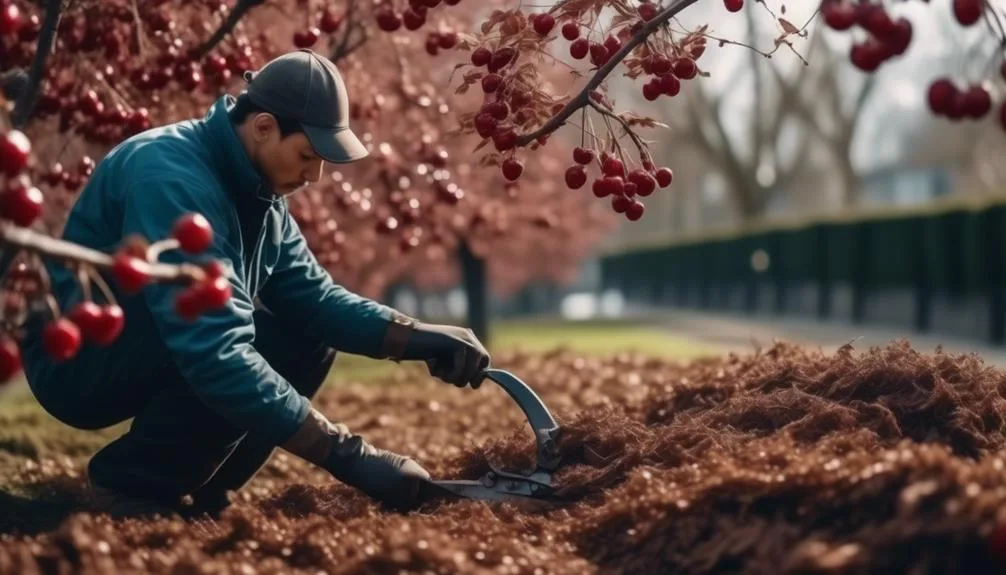Preparing cherry trees for winter is essential as the weather turns cold. Even though they may appear inactive, getting them ready for the winter is crucial for their health and growth in the spring.
From trimming to protecting against frost, there are important steps you can take to safeguard your cherry trees.
Let's explore the necessary preparations to help your cherry trees thrive through the winter and beyond.
Pruning Cherry Trees in Fall
As fall approaches, it's essential to prepare your cherry trees for the winter by pruning them to promote healthy growth and fruit production next season. When pruning your cherry trees in the fall, it's important to consider the soil fertility and branch structure.
Pruning helps to maintain soil fertility by allowing better air circulation and sunlight penetration, which are vital for the overall health of the tree and the production of quality fruits. Additionally, focusing on branch structure during pruning is crucial for shaping the tree and promoting balanced growth.
Protecting Cherry Trees From Frost
To protect your cherry trees from frost, it's crucial to take into account the pruning done in the fall, ensuring that the tree is adequately prepared for the winter weather.
Here are three essential frost protection techniques and winter weather preparation tips:
- Mulching: Apply a thick layer of mulch around the base of the tree to insulate the roots and retain soil moisture. This helps regulate soil temperature and protect against sudden temperature drops.
- Covering: Use frost cloths or blankets to cover the cherry tree during nights with forecasted frost. This provides a temporary barrier against freezing temperatures and reduces the risk of frost damage.
- Watering: Keep the soil around the cherry tree moist, as hydrated trees are more resistant to frost. Watering the tree before a frost event can help protect it from extreme cold.
Mulching Cherry Trees for Winter
Consider mulching your cherry trees before winter sets in to provide essential insulation for the roots and maintain soil moisture levels. Mulching not only protects the trees from extreme temperatures but also helps retain moisture, preventing the soil from drying out during the winter months. Here's a simple guide to mulching your cherry trees effectively:
| Materials | Considerations |
|---|---|
| Organic matter such as wood chips, straw, or shredded leaves | Provides insulation and retains soil moisture |
| Mulch fabric or plastic sheeting | Offers additional protection from freezing temperatures |
Mulching your cherry trees before winter is a proactive step to ensure their health and vigor come spring. By retaining soil moisture and providing winter protection, you can help your cherry trees thrive despite the harsh winter conditions.
Hydrating Cherry Trees Before Winter
Mulching your cherry trees before winter not only provides essential insulation for the roots but also helps maintain soil moisture levels, ensuring the trees are well-prepared for the cold season ahead. However, pre-winter watering is equally crucial to ensure your cherry trees enter the dormant period adequately hydrated.
Here's what you need to know:
- Timing is Key: Water your cherry trees deeply in late fall, ensuring the soil is moist but not waterlogged before the ground freezes.
- Focus on Root Zone: Direct the water towards the root zone, allowing it to penetrate deeply into the soil to reach the roots.
- Protect from Drying Out: Hydrating the trees before winter helps prevent the roots from drying out during the cold season, promoting healthy growth come spring.
Inspecting Cherry Trees for Pests and Diseases
Inspect your cherry trees regularly for signs of pests and diseases, ensuring early detection and prompt treatment to maintain their health and productivity. Effective pest management and disease prevention are crucial for the well-being of your cherry trees. Here's a handy table to help you identify common pests and diseases, along with their respective treatments:
| Pests | Diseases |
|---|---|
| Aphids | Brown rot |
| Caterpillars | Leaf spot |
| Cherry fruit fly | Powdery mildew |
| Japanese beetles | Bacterial canker |
| Spider mites | Root rot |
Conclusion
After completing these essential steps to prepare your cherry trees for winter, you've set the foundation for their resilience in the coming months.
Stay attentive to their needs during the winter, making adjustments as necessary to support their well-being.
Your thoughtful care now will contribute to their thriving when spring arrives.
Happy gardening!

My interest in trees started when I first saw the giant sequoias in Yosemite.
I was a teenager then, and I remember thinking, “I need to learn more about this.”
That moment stuck with me.
A few years later, I went on to study forestry at Michigan Tech.
Since graduating, I’ve worked in a mix of hands-on tree care and community education.
I’ve spent over ten years helping people understand how to plant, maintain, and protect the trees in their neighborhoods.
I don’t see trees as just part of the landscape.
They are living things that make a real difference in our daily lives.
